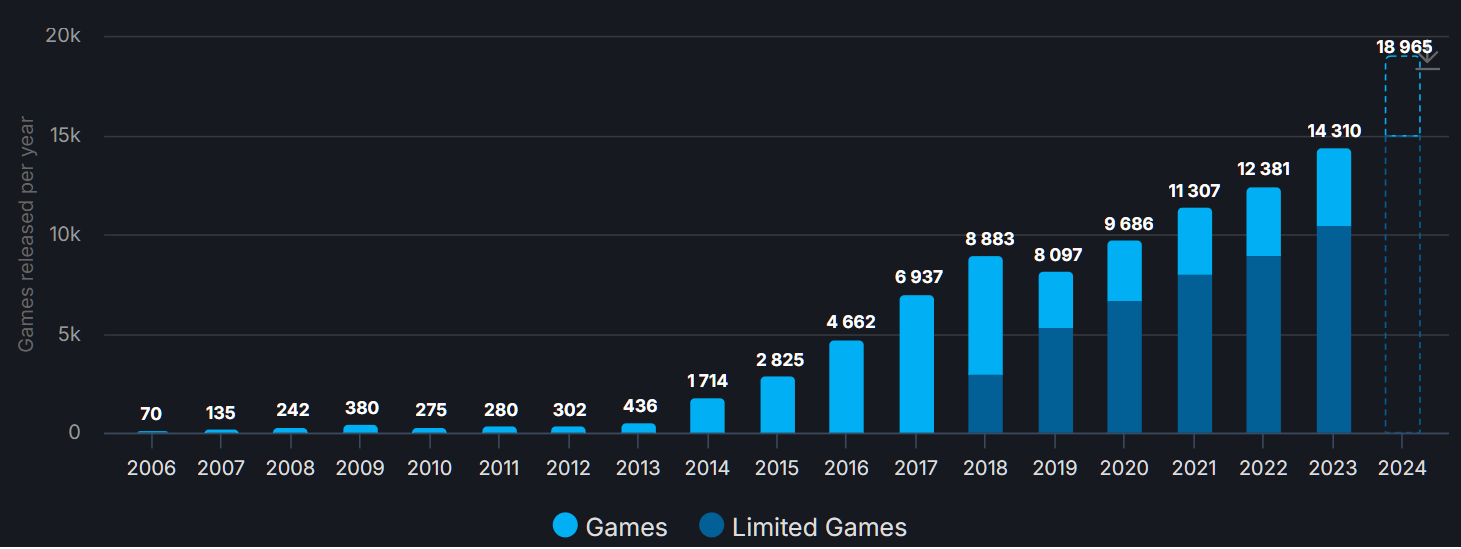The video game industry is currently in a tough spot, as it undergoes a chaotic self-correction, causing studios to shut down and many people to lose their jobs. It’s almost like the industry grew too fast for its own good, and one of the clearest signs of this is the sheer number of games competing for attention.
A great place to see this is on Steam. As the biggest PC gaming storefront, it’s overwhelming just how many games are released every day. In fact, according to Steam tracking site SteamDB, 2024 saw the biggest increase in releases since 2017.
Last year, nearly 20,000 games were released on Steam—up from 14,310 in 2023. That’s a staggering 32.52% increase.
Now, while this isn’t the largest increase Steam has ever seen (2014's jump of 293.1% from 400 to 1,714 releases is hard to top), it's still pretty massive. That surge in 2014 happened when Valve decided to be less picky about what could be released on their platform, and the floodgates opened.
Fast-forward to today, and Steam is seeing an average of 51.95 games released every single day. With so many games coming out, it’s no surprise that many of them are getting lost in the shuffle, struggling to stand out in a sea of new releases.
Despite this, Steam is thriving. According to VGInsights, the platform brought in $11 billion in 2024, up from $8.8 billion in 2023 and $7.6 billion in 2022. The number of people using Steam is also on the rise, with a record 39.3 million people logged in simultaneously on December 15, 2024—surpassing the previous record of 33.6 million set in 2023. It’s looking likely that Steam will break 40 million concurrent users in 2025.
So, while more games are being released than ever, more players are jumping in too. But here’s the big question: how sustainable is this growth? In 2024, some major titles struggled to hit their sales targets. Steam’s own data shows that only 15% of users’ time was spent playing games released in 2024. Meanwhile, 47% of their time was spent on titles that are 1-7 years old. On consoles, older games like Minecraft and free-to-play hits like Fortnite dominate the most-played charts.
Speaking of the competition for attention, let’s talk about "limited games." SteamDB categorizes games as either regular releases or "limited games." Limited games are those that haven’t gained enough player engagement or sales to escape the “Profiled Feature Limited” tag that Steam assigns them. This tag means these games can’t show up on people’s achievement lists or be used to craft medals. The goal is to prevent abuse of Steam’s trading card and achievement systems.
It’s important to remember that not all limited games are bad or “shovelware.” Some could be small passion projects or free releases that never quite found an audience. Of the 18.9k games released on Steam in 2024, a whopping 14.9k were classified as limited games. But if we focus just on titles that managed to unlock profile features, the number drops to 3,984. That’s only a small increase over last year’s 3,878, and in 2022, it was just 3,495.
This suggests that while the total number of releases on Steam is skyrocketing, the number of games actually finding an audience is growing at a much slower pace. In other words, many of these games get buried under the avalanche of new releases.
The situation is similar on other platforms like PlayStation, Xbox, and Switch. For example, the PlayStation Store had 190 releases listed since December 5th. While this isn't as crazy as Steam's numbers, it’s still a lot to sift through. No wonder indie games have a hard time standing out in such a crowded market.
In short, the game industry is in a weird place. There’s a ton of content being pushed out, but the sheer volume makes it harder for players to find the gems. It's going to be interesting to see how things evolve as the industry continues to wrestle with this growth.





.png)
